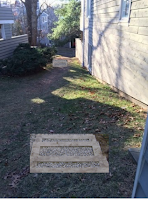By Mary Sapp
As you are probably aware, Lakeport’s hilly topography poses challenges for our community. For example, a number of owners have installed steps on their property to help them more safely access their docks and back patios. But the slopes, especially the steep grades, create another problem for Lakeport properties and Lake Thoreau: storm-water runoff that leads to mud, erosion, and streams of dirty water that flow into storm drains that all empty into our lake and into the Chesapeake Bay watershed. In fact, some areas of Lakeport are designated as part of the Chesapeake Bay Resource Protection Area (RPA)—you can find links to maps and other information about the RPA https://www.fairfaxcounty.gov/landdevelopment/faqs-resource-protection-areas to see if part of your property is included and what that means for you.To try to protect the quality of its waters, the Commonwealth of Virginia encourages property owners to engage in best practices to reduce the quantity of stormwater that leaves your property and to improve the quality. As an incentive, the Northern Virginia Soil & Water Conservation District (SWCD) offers grants for approved projects proposed by HOAs, civic organizations, religious institutions, and individual property owners. In 2020 Lakeport qualified for two grants to install a rain garden and conservation landscaping between 1952 and 1954 Lakeport Way. The rain garden has successfully captured runoff from four downspouts, but unfortunately surface-level runoff is still causing erosion between 11110 and 11112 Lakespray and mud between 1952 and 1954 even after the owners paid to install rock steps so they could safely reach their back patios.
We consulted with the contractor for our rain garden and the NoVA SWCD, who determined that most of the current runoff (which creates an obviously flowing stream during a heavy rain) is from the grassy area between 11100 and 11112 Lakespray. They proposed the installation of five “infiltration steps” on the four-foot strip of common property between these two homes to capture and temporarily store the surface water before infiltrating it into the soil over several days based on a design prepared by a Soil Scientist at NoVA SWCD. The five 3.5’ W x 4’ L steps (three located on the steepest part of the hill and another two near the bottom, as shown in the photo rendering to the right) will help terrace the area to slow down the water, but the real value is the 3’x3’ reservoirs filled with rocks beneath the steps (the top three will be 20” deep and the bottom two 31” deep).In addition to controlling and minimizing runoff and conserving that water within the landscape, the infiltration steps will make it safer for contractors and anyone else going down that hill, although its use as a route to Lakeport Way (or for sledding/skiing 😊) is discouraged. The placement of these steps will also encourage anyone walking there to do so on common property rather than on private property.
Installation of the steps is contingent on final approval by RA’s Design Review Board and approval of a $3,500 grant from NoVA SWCD that would cover most of the cost.
Note that if you have stormwater issues, you might want to investigate applying for your own grant from NoVA SWCD to fund one of their best practices (e.g., a rain barrel, conservation landscaping, or a dry well). See https://vaswcd.org/vcap for more details and links to eligible practices.



No comments:
Post a Comment